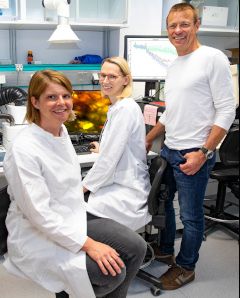Until now, the genetic lung disease cystic fibrosis has been considered to be incurable. For a long time, only symptomatic treatment was possible. With the first approval of a so-called CFTR modulator for patients with certain mutations, hopes have been raised that an etiological therapy for more patients will also soon be found. Over 2.000 different mutations of the CFTR gene are responsible for different defects in the CFTR ion channels and thus the severity of the disease. It is therefore not possible to provide therapy for all patients with a single medication.
Prof. Dr. Ulrich Martin and Dr. Ruth Olmer, scientists at BREATH, the Hannover site of the German Center for Lung Research, together with their colleagues, have now developed a method of identifying possible CFTR modulators using high-throughput screening. This modern method is based on the use of induced pluripotent stem cells (iPSCs) harvested from human body cells by reprogramming. These cells can be multiplied almost infinitely in the laboratory and finally differentiated into various cells. To produce iPSCs with certain disease-specific mutations, just a small sample of the patient’s blood is sufficient.
Dr. Sylvia Merkert and Dr. Madline Schubert used iPSCs with the CFTR gene mutation p.Phe508del for their new method. In the laboratory, a genetic fluorescence reporter was introduced into these cells, whose fluorescence intensity correlates with the functionality of the CFTR ion channel. Since it is currently still very costly to differentiate lung cells in large quantities, the iPS cells for high-throughput screening were differentiated instead into enterocytes that are faster and simpler to produce. If these cells are treated with potentially effective substances, through the change in the fluorescence signal in real-time the activity of the channel can be measured and it can thus be determined whether a substance can become a possible medication. In this way, the researchers at BREATH have already studied over 42.500 different substances, of which about 20 were found to be potentially effective on the activity of the CFTR ion channel. These results have been published in the journal Stem Cell Reports.
Prof. Ulrich Martin summarizes the importance of this work: ”Our results show that disease-specific iPSCs are very well suited for use in carrying out automated drug screenings for CFTR modulators“.
“The use of patients‘ cells in the first screening process is a significant improvement on earlier test systems that were based on tumor cell lines. Our next step will now be to study further, together with our cooperation partners, the ten most promising substances in primary lung cells. It could, however, still prove to be the case that they are not suitable drug candidates. It may also be necessary to reduce toxic effects by chemically modifying the molecules”.
In general, the patients’ own induced pluripotent stem cells allow many symptoms of, for example, the lung, the heart or the vascular system, to be reproduced in the laboratory. “In future we also wish to use small, multicellular organoids in order to more closely simulate the human conditions. Modern high-throughput methods together with stem cell technology will in future shorten the time required to develop new drugs and distinctly reduce the number of animal experiments required“, Dr. Olmer describes as the further plans for her team.
Link to original publication: here.
Text: BREATH / SM, AB
Picture: Karin Kaiser / MHH

[Translate to English:] Arbeitsgruppe von Prof. Dr. Ulrich Martin (rechts), Dr. Ruth Olmer (links) und Dr. Sylvia Merkert (Mitte)